Maybe you have had great luck with people responding to your shares on 23andme but most of us have at best 30% of our share requests accepted (of 1800 DNA relatives my Dad has 338 shares and 40 introduction accepted so just under a 20% acceptance rate). This is especially frustrating when someone is clearly a close relative and does not respond. Of course some of the reason for the lack of response is that the default setting on 23andme is to not send emails when there are messages in the inbox. Fortunately the occasional email from 23andme about new relatives or news does get some of them to log in and see the invites. I always get several acceptances from old shares after one of those broadcast emails.
Yes I can hear those of you who have tested at familytree DNA laughing and say well we can see the shared DNA. But you also may never hear back from some of the most promising leads who do not have much of a tree posted and more importantly you cannot compare people you match with each other which we can do with our shares. There are pluses and minuses to each testing company.
Below are a few of my closest non accepting DNA relatives. S M is public and accepted contact but not sharing. G S is public and responded to a message asking if he was related to my S family from Etne with a no, but has not shared. I made an error on the 3rd introduction to one relative and now can no longer contact them, at least from this account.
So for those of us using 23andme I will use these matches as a case study on how to find the DNA segments where they match my Dad using “Countries of Ancestry.” This only works if your relative has entered the countries of origin for their parents and grandparents.
First a little known trick, you can download a CSV of all your DNA relatives by clicking the Download button on the top right of the page when on the DNA relatives page.
A box will come up asking you where to save it on your computer. Note that the default file name is relative_finder_Your_Name_digitaldate.csv
In order to get to the page called “Countries of Ancestry,” where we may find the overlapping DNA, first click on “Ancestry Tools” in the menu that appears when you put your cursor on “My Results” in the top bar, as shown below:
Then on the Ancestry Tools page, select countries of ancestry.
This will take you to a fun page where you can mouse over the colors on the chart to see more relatives. Some of whom may not be on your DNA relatives chart. You can use the 23andme search feature to find their profiles and send them an invite.
But that is not the topic of this post. Scroll down that page and click on the big blue button with your name on it as shown in the image below.
This is the graph from my Dad’s Countries of Ancestry with an example of a mouse over showing an anonymous relative. But it is that big blue button at the bottom that gets you the CSV file that we want. It will have a list of all your DNA relatives who have answered their ancestry questions. You may need to answer that survey also but I am not sure.
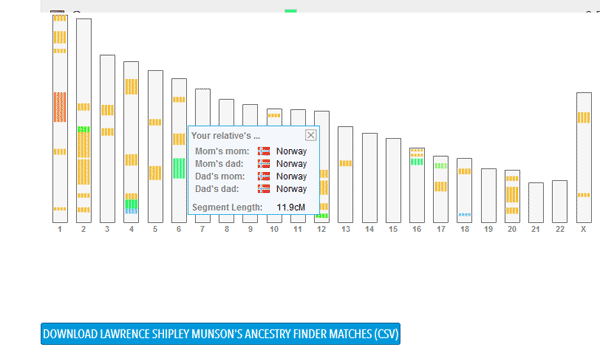
After you click that button a box comes up asking where to save this on your computer. The default file name is ancestry_finder_Your_Name_digitaldate.csv – after this file is saved, open it in your favorite spreadsheet program; double clicking on it will typically accomplish this on a PC.
Once you have the ancestry finder file open in your spreadsheet program (openoffice for me) sort it by “Match Name.” Make sure the whole file is selected before you sort it and indicate that the columns have named headings.
I searched for G S nor S M by name and neither was there. Not surprisingly neither of them has filled out the ancestry information. I will try asking them to do so by messaging them. Now to the anonymous puzzles. I have 3 people with 3 segments shared and .54% shared DNA. I may not be able to tell them apart but I can find them if they have done the survey. I also have one person with .52% and 5 segments.
Since I am not interested in Ashkenazi DNA for Dad’s ancestors, I deleted those four columns in the spreadsheet, made the other columns narrower, and shortened the column headings so that it fit on my screen. Then I looked at just the anonymous matches. I eyeballed them for any that had three or more entries, summed their totals, deleted the others, and used colors to better read the important columns. Below are my findings. Looks like I found the woman with five matching segments.
Only two of the people with three segments have enough DNA to qualify for .54% and no I did not do the math. I just looked at a known relative who has .48% and 35.4 cMs and since these two have more made the assumption. I am going to assume the one with Norway ancestors is the one who indicated Norway in their profile and the other is the one who indicated Northern Europe. I am guessing that the one who did not indicate ancestry is the one who is not in this sheet.
Now I can add their segments to my spreadsheet. If they overlap with other relatives who triangulate with another of my family’s kits that I control, I can go through the same process in the other account and see if a person with the same information and similar segments (exact not necessary, boundaries are fuzzy) is there.
Perhaps if I find which family line they are related to and reinvite them with more information they will at least accept contact and share genealogical information. I also plan on sending a link to Roberta Estes’ blog post on what genome sharing at 23andme really means, I am hoping it will make them more comfortable with this process!
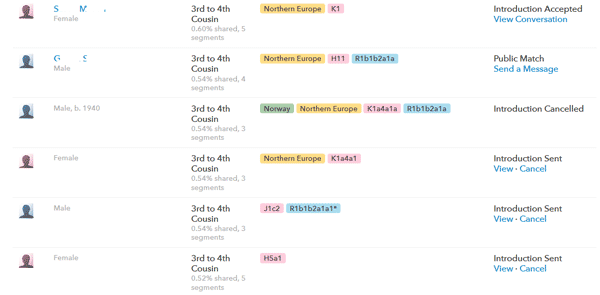
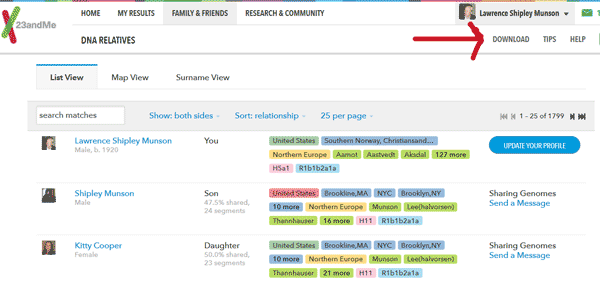
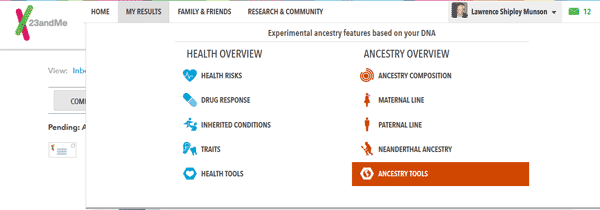
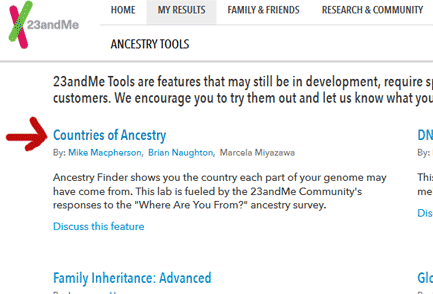
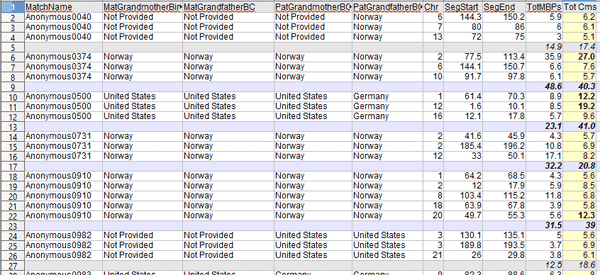
I presume that your also using Gedcom? One might presume some of your matches are listed there too, and the fact that they have taken the trouble to upload, could imply they will respond when contacted? Just a thought.
BR
MikeB
I think you mean GEDmatch and no none of these matches are listed there. But perhaps I will start including the suggestion to upload there in my sharing messages!
I still can’t get a grasp on using the Countries of Ancestry to work for me. Mainly because I know who came from the foreign countries and I know what to look for in people’s profile.
And even after a year now of having done DNA (first with FTDNA, then 23andme & a few mos. ago Ancestry), I still can’t see how matching specific segments on chromosomes can help, with the exception of triangulation. It seems to boil down to just a matter of having good trees and comparing.
Another issue I still can’t get anyone to answer on, is how much of this is really IBS? Esp. with less than 0.70%. I used that example only because last year I spent 52 hours, a total of 19 days at the library going through rolls & rolls of microfilm over & over again finding the ancestors of 3 of my matches, all of whom never had any info. passed their grandparents. So it was up to me to figure out who in their tree may be my ancestor. This person I matched at 52cM (0.70%) was the only successful one I found, and two ways too, which is why it took me longer. So since my other 2 matches are less than 0.70%, I take it that there is a chance of it being IBS and/or our common ancestor(s) lived beyond the 1700s. Documentation therefore becomes harder to obtain for this branch of mine.
23andme gives me five 2nd cousins, twenty-six 2nd-3rd cousins, forty-five 2nd-4th cousins and one 2nd-Distant cousin. Many of these are the same situation, possibly IBS, but I know that these people don’t have nothing in common with my ancestors that was born after 1799, esp. if they say 2nd cousins. This is nothing compared to my mother’s matches on FTDNA, with only two 1st-cousin to uncle-nephew/aunt-niece type of matches, twenty-four 1st cousin matches and thirty 2nd-3rd cousin matches.
I recently contacted a 4th – 5th cousin match (FTDNA) of mine, and although we know our families have ties to the same geographic area, I can’t see any of their family names intersecting with my families. I told her about IBS and she too believes that we all are interrelated multiple ways, but she just don’t realize it could’ve been from way back when too.
You are correct that the segment information is mainly useful for triangulation. Since I have many family members tested (me, dad, my brother, a first cousin, 2 second cousins, several third cousins, many many 4th and 5th cousins … Hmmm a genetic interest in this stuff?)
So after 2 years of an hour or two most days on genetic genealogy, I am starting to see some patterns. There are certain segments Dad has that I can know the MRCA for when I see whether they triangulate with me or my brother. Also certain localities with enough intermarriage back in the 1500 and 1600s to muddy the waters …numerous folk to whom I am doubly and triply related to back then. Norwegian records are excellent back to the 1500s and earlier which helps a great deal.
So if matches triangulate they are not IBS but they can easily be too far back to find. We need a term for that ITFB (inheritance too far back?). It is when my Dad matches 3 or 4 people that do not match each other that I know it is IBS.
Finally, the percentage number is of far less interest than the size in cM of the longest segment and whether there are more than one segment matching, both greater than about 7cm. Most matches of one segment that are less than 10 cM will be pretty far back. I have many posts on this subject
Also different people have different goals, making a map of the DNA from different ancestors is one of mine (see my chromosome mapping tool)
I have a 1st cousin match but he was adopted and we can’t figure out from which side of family we are related. Help
Michelle, have a look at DNAadoption.com for methodology. Get some cousins on each side of your family to test to help narrow this down. Even better if your parents are available for testing. Have you both uploaded to GEDmatch?
Where did you test? If 23andme then you may be able to figure out which side by looking at the ancestry composition for your matching segments … Unless your parents have the same ancestry
I was wondering why my Dad doesn’t show in the CofA downloaded file? I input all his grandparent details etc and he is as public as can be on 23andMe.
Thanks.
Close relatives will not show. Your Dad matches you on every segment so that would hardly be useful. Neither my Dad nor my brother nor my aunts show in CofA for me.
Apparently they have taken this feature off of 23andMe Ancestry Tools, and I am still on the “old” 23andMe.
Margaret, you are correct. 23andme has removed this feature. We all had a lot of warning so many of us downloaded this in a CSV.